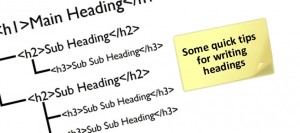As humans we are forever evolving, how we gather information is no exception. With so much information now available at the tap of a few keys and buttons (or screens). It's no surprise that we have developed new skills for quickly determining if a website contains what we need.
Headings are not the only factor involved of course, people consider page load time, good graphics, design and layout also (to name a few). But in the search for information headings are the signposts most people follow.
So, what is a heading? A heading is the title or sub-title at the beginning of a page or paragraph. For a good start, your heading should clearly outline what the content that follows is about, and what its purpose is. What else is important?
Use keywords in your headings
Aside from being great for Search Engine Optimisation (SEO), it also helps readers. When scanning a page readers generally look for information using common/familiar phrases and keywords, having these in headings lets them know that the content that follows is what they're after.
Break up large amounts of content with headings
The majority of readers are instantly put off by a wall of text. Break your content up into related paragraphs using headings and sub-headings as much as possible.
Use the proper format and order of headings
This one's a bit nerdy, but if you're one of our clients and you've had your site training you will know what I mean. Most content management systems use heading tags in the editor. These are ordered and generally the font size decreases as the number gets higher. For example you have Heading One, Two and Three. Every page with content should start with a Heading One, and any heading under that should be Heading Two - any headings within a Heading Two should be set as heading three. This is probably confusing, so here is an example of the structure:
- Heading One (main heading of the content)
-
(Your Content)
- Heading Two
-
(Your Content)
- Heading Three
- (Your Content)
- Heading Three
- (Your Content)
- Heading Two
-
(Your Content)
And so on and on and on.
Write meaningful, informative headings
Headings need to make sense out of context. Consider the reader scanning your page, they may not actually be fully reading the content and miss out on important facts. You can use headings to highlight important facts about a product that the reader would find relevant when considering a purchase and might otherwise miss. For example you could use the heading "We only use natural ingredients" followed by a paragraph about this. A good rule of thumb is to pretend that your heading is being used as the text of a link to the content that follows.
If you have any more questions about headings let me know!









